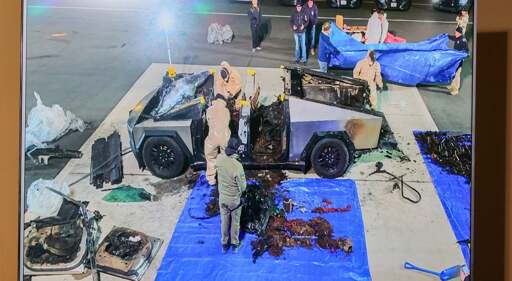At the current rate of horrible fiery deaths, FuelArc projects the Cybertruck will have 14.52 fatalities per 100,000 units — far eclipsing the Pinto’s 0.85. (In absolute terms, FuelArc found, 27 Pinto drivers died in fires, while five Cybertruck drivers have suffered the same fate, at least so far.)



Him and his libertarian friends fuck up left and right. Crashing startups and just getting more money for another. Constant recalls. Blowing up rockets until it works.
Yet they hold the government to a standard of being perfect and high performing with no room for failure. NASA can’t be blowing up rockets. As soon as they do the world comes down on them.
And Trump is the biggest fuckup of all these guys.
I see you don’t understand testing things before they are safe for humans to be inside of. So by this logic, you are saying “blowing up rockets until it works” is also saying “crash testing cars is stupid.”
<blank stare>
If NASA was funded properly, we may not be leaning on one private company, whose owner is a nazi, to be paving our way forward for daily space activities. Can’t say things won’t blow up during testing, but at least it won’t be headed by that guy.
The issue isn’t the way of testing, but the two standards. If Musk blows up rockets in testing it’s a genius move with rapid iteration. If NASA does this it’s irresponsible handling of tax payer’s money on risky endeavors.
I stand by my comment. Things break, shit happens, this is why we test them.
Blowing up rockets until it works is a far better approach than trying to get everything to work on the first try and ending up with a hugely overpriced white elephant.
Sure, if it was cheaper than just doing it correctly the first time which it’s not
How do you do something “correctly” when nobody knows what that is? If your main priority is to do it “correctly” you will never develop anything fundamentally new.
Okay so say your testing a brand new rocket engine idea. It uses a fuel nobody has tried to use before. So what you do is you figure out how much energy this fuel has and do some math to figure out how much you’ll need to take with you for the typical rocket. You design an engine for this spec or better and thoroughly test it to make sure it’s behaving like expected. You eventually mount it to a rocket and make sure in practice it behaves as you expect. Next you put a payload in the rocket and test it again. If at any point things don’t behave as expected you have to fix your whole model.
SpaceX struggles to go a launch without their engines destroying themselves. Perhaps they should go back a few steps?
A rocket is not fundamentally new and hasn’t been for almost 100 years.
Rockets perform correctly when they deliver their payload to the correct orbit.
You can calculate the energy density of fuels, the efficiency of your engines at various atmospheric pressures, and determine the payload size you can deliver with your engines and fuel. Blowing up rockets for “tests” is so 1950s. We have whole college programs on rocket design. We have desktop computers more powerful than anything available in the 1960s, and NASA managed to design the Saturn V, a rocket of similar size to starship, with the computers of the time and fucking slide rules. The Saturn V had its problem, but each rocket managed to deliver its payload and perform its part of the mission without blowing up.
Your comment is classic tech bro. No understanding of real engineering principles and only a desire to shove some shit out of the door as fast as possible.
There are two American rocket projects in the works that can carry a significant payload to the moon. One is using existing parts in a new configuration. It had one successful launch and cost $4B ($2.5B in launch costs alone). One is building a largely new system and improving existing elements and is estimated to have cost less than $2B so far, although it hasn’t reached the moon yet. That said, they have done 7 tests, at least 3 with a full configuration. How is that not better than the other option?
Also, you are acting like there are no fundamental advances happening in space engineering. Sure, the physics is pretty well-known, but the engineering problem of landing and reusing stages/rockets commercially has only been done since the Falcon series, so I think it’s safe to assume the technology and associated product lines is still maturing.
You are 100% correct about modeling being more advanced. It proves just how stupid Musk is. Musk at one point asked for the code that twitter uses to be printed on paper… on fucking paper! Like what the hell is this? The 1970s? I wrote code in the 90s and I never heard of anyone printing out raw code before him.